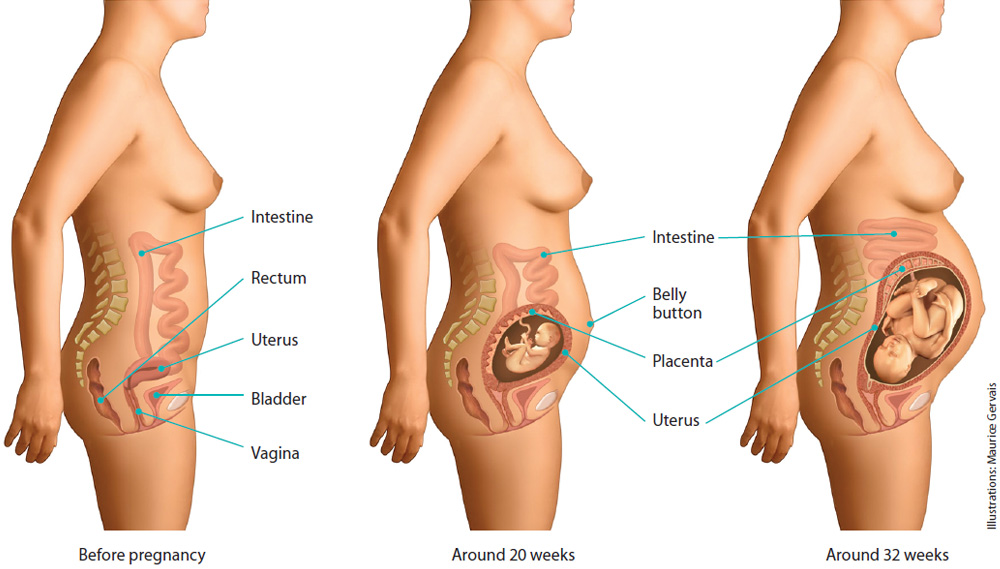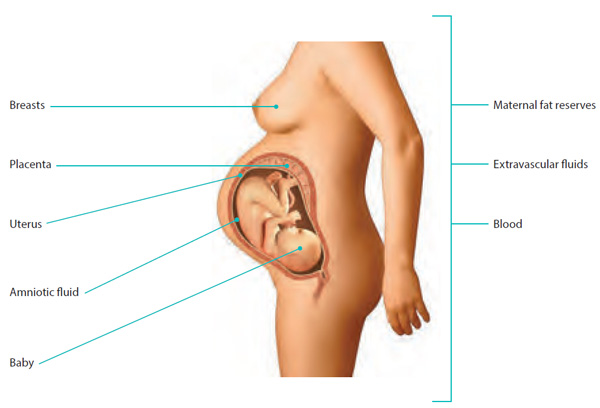Physical changes
Pregnancy is a period of rapid changes in your body. Most of these changes are temporary and will gradually disappear after your baby is born. Some of them are pleasant, while others can cause a certain amount of discomfort.
Heart, blood vessels and lungs
During pregnancy, your heart rate can increase by up to 10 beats per minute. Your heart shifts slightly within your rib cage as the baby grows and your uterus expands. The volume of your blood increases to meet the needs of the fetus.
Pregnancy also brings about changes that can affect your breathing. Many women feel a little short of breath when they’re pregnant. Shortness of breath comes on gradually and remains mild. It can start as early as the first months of pregnancy.
Hair
Head and body hair growth can change during pregnancy. Some women may experience increased hair growth on their bodies and have a thicker, fuller head of hair. A few months after the birth, it is not uncommon to experience more hair loss than usual.
Skin
Changes in hormone levels during pregnancy stimulate the skin and scalp, causing a noticeable effect in some women. Changes to your skin and scalp shouldn’t be cause for concern, as most will diminish or disappear altogether in the months following the birth.
Hyperpigmentation
Most pregnant women will find that their skin darkens. This condition is known as hyperpigmentation. Hyperpigmentation tends to be localized, usually appearing as a thin dark line between the belly button and the pubis. It can also occur as a darkening of the perineum, anus, neck, armpits, the areola on your breasts, or the skin around the belly button.
The pregnancy mask some women get is a result of hyperpigmentation. It is characterized by the appearance of brown patches on the face.
Hyperpigmentation and pregnancy mask can be aggravated by sun exposure. To protect yourself, you can use sunscreen (see Sunscreen).
Hyperpigmentation and pregnancy mask clear up after the birth of the baby and generally disappear altogether within a year.
Stretch marks
Stretch marks can also develop during the second half of pregnancy. They are mainly visible on the tummy, breasts, and thighs, but also in the armpits or on the lower back, buttocks, and arms. Stretch marks form when a deeper layer of skin stretches as the body changes. They are initially a pinkish or purple colour, and gradually become less apparent over time.
There is no proven method for effectively preventing or treating stretch marks. The massaging motion used to apply moisturizing cream may help reduce them somewhat, although the ingredients of the cream themselves appear to have little effect.
Other changes
Some women develop acne, which usually disappears after the pregnancy.
Hormonal stimulation of the skin can result in the appearance of acrochordons (skin tags)—tiny benign skin growths that are most common in skin folds such as around the neck and armpits.
Some women may develop angiomas between the second and fifth months of pregnancy. Angiomas are little red patches on the skin formed by blood vessels. Most angiomas will disappear on their own within three months of giving birth.
The perineum and pelvic floor
During pregnancy, numerous changes (e.g., hormonal changes, weight gain) impact the perineum and pelvic floor. This can increase the risk of urine leakage.
Exercises to keep the pelvic floor in shape can help reduce the chance of leakage. In addition, certain pelvic floor muscle stretches can reduce the risk of tears and pain after childbirth. Talk to your prenatal care provider about it.
Reducing caffeine intake, staying well hydrated, exercising, and eating a high-fibre diet are all lifestyle habits that can help reduce the risk of urine leakage.
Bladder and kidneys
Bladder function changes during pregnancy. The kidneys increase in volume and filter more liquid. This can trigger a more frequent or urgent need to urinate. Later in pregnancy, the uterus expands as the baby grows, putting pressure on the bladder. This increases the urge even more.
You will probably feel the need to urinate more often at night, too. During the day, your body tends to accumulate water in your tissues. When you go to bed, these water reserves are sent to your kidneys and you feel the urge to go—again!
Stomach and intestines
Digestion often slows down during pregnancy due to hormonal changes. This can cause heartburn (see Heartburn and acid reflux) and constipation (see Constipation).
Breasts
Your breasts may become more sensitive and increase in size. The blue veins that crisscross their surface may become more visible.
Your nipples and areolas prepare for breastfeeding by growing slightly. They may also become darker. Little bumps form on the areolas. These bumps are glands. They produce oil that will help keep your skin moisturized and protected during breastfeeding.
Beginning at 16 weeks, the breasts start producing colostrum. Colostrum is the first milk produced for a newborn baby. Some women may leak colostrum during pregnancy. This is completely normal.
Uterus
Before pregnancy, your uterus is the size of a small pear. As your pregnancy advances, it expands to meet the needs of the fetus and changes shape and position in your abdomen.
The increasing weight of the uterus moves your centre of gravity further forward. This can cause your posture to change. That’s why some women walk differently than they did before becoming pregnant.
Vaginal discharge
Women often have more vaginal discharge during pregnancy due to hormonal changes. The discharge is usually whitish in colour, slick, and odorless.
Growth of the fetus in the uterus

Ligaments and joints
Pregnancy hormones tend to make the ligaments supporting your joints loosen up gradually, especially in the pelvic area. For some women, this can cause pain during physical activity, or even while resting.
Fat reserves
Women accumulate fat reserves throughout pregnancy, especially in the tummy, back and thighs. These reserves store energy and are necessary to ensure that the pregnancy and breastfeeding go well.
Weight gain
![]() Weight gain during pregnancy is normal and allows you to lead a healthy pregnancy.
Weight gain during pregnancy is normal and allows you to lead a healthy pregnancy.
Women gain weight during pregnancy because their baby is growing and their bodies are changing
The weight gain corresponds to the weight of the growing baby, but also the weight of the uterus, the placenta, and the amniotic fluid. The breasts, maternal fat reserves, blood, and extravascular fluids also contribute to weight gain (see below Distribution of weight gain during pregnancy).
Adequate weight gain helps you lead a healthy pregnancy, but it’s not the only factor. A healthy diet (see Eating well), and regular physical activity (see Physical activities) will also have a positive effect on you and your baby’s health.
Distribution of weight gain during pregnancy

Illustration: Maurice Gervais
Changes in weight during pregnancy
At the beginning of pregnancy, your appetite may vary depending on whether you have morning sickness (see Nausea and vomiting) or pregnancy cravings (see Appetite, cravings, and aversions). Some women gain more weight; others lose weight. Your weight will adjust as the months pass.
![]() You will put on weight gradually.
You will put on weight gradually.
By the end of the first trimester, you can expect to have gained between 500 g and 2 kg (1 to 4.5 lb). Most weight gain occurs during the second and third trimesters, as your baby starts to grow faster. During these two trimesters, you can expect to gain between 225 and 500 g (1/2 to 1 lb) per week, depending on your pre-pregnancy weight.
Weight gain can vary greatly from one woman—and one pregnancy—to another.
There’s no need to weigh yourself at home. Your prenatal care provider will monitor your weight on a regular basis. If you’re worried about your weight gain, don’t hesitate to let your care provider know.
Women carrying more than one baby (e.g., twins, triplets) will gain more weight. If this is the case for you, your prenatal care provider will take this into account.
Living with the changes
![]() Pregnancy transforms women’s bodies. Give yourself time to adapt to the changes. They’re proof of your body’s amazing ability to give life!
Pregnancy transforms women’s bodies. Give yourself time to adapt to the changes. They’re proof of your body’s amazing ability to give life!
Every woman experiences pregnancy differently, but the transformations affecting your body can have an impact on the way you see yourself.
Some women are comfortable with the physical changes. Like their growing belly, they may see them as signs of the baby developing inside of them and the future addition to the family.
Other women find it harder to accept their changing bodies and new image. The day-to-day symptoms and discomforts of pregnancy can make this even more difficult.
If you’re experiencing discomfort or dissatisfaction, don’t hesitate to express your feelings or talk it over with someone you trust.
Areola: Darker area of the breast around the nipple.
Fetus: Developmental stage of a human being in its mother’s womb, from 10 weeks of pregnancy until birth.
Perineum: The part of the body between the vagina and the anus.


